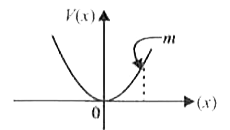An automobile of mass 'm' accelerates starting from origin and initially at rest, while the engine supplies constant power P. The position is given as a function of time by :
(9P8m)12t32
(8P9m)12t23
(9m8P)12t32
(8P9m)12t32
The correct Answer is:D
To solve the problem of an automobile of mass 'm' accelerating from rest under constant power 'P', we can follow these steps:
Step 1: Relate Power, Force, and Velocity
We know that power (P) is given by the formula:
P=F⋅v
where F is the force and v is the velocity of the automobile.
Step 2: Express Force in Terms of Mass and Acceleration
Using Newton's second law, we can express force as:
F=m⋅a
where a is the acceleration of the automobile.
Step 3: Substitute Force into the Power Equation
Substituting the expression for force into the power equation gives:
P=m⋅a⋅v
Step 4: Express Acceleration in Terms of Velocity
Acceleration can be expressed as:
a=dvdt
Substituting this into the power equation, we have:
P=m⋅dvdt⋅v
Step 5: Rearranging the Equation
Rearranging the equation gives:
dvdt=Pm⋅v
Step 6: Separate Variables and Integrate
We can separate the variables:
vdv=Pmdt
Now, integrate both sides. The left side integrates from 0 to v and the right side from 0 to t:
∫v0vdv=∫t0Pmdt
This gives:
v22=Pmt
Step 7: Solve for Velocity
Multiplying both sides by 2 gives:
v2=2Pmt
Taking the square root, we find:
v=√2Pmt
Step 8: Relate Velocity to Position
We know that velocity is also defined as:
v=dxdt
Substituting for v gives:
dxdt=√2Pmt
Step 9: Separate Variables and Integrate Again
Now, separate variables again:
dx=√2Pmtdt
Integrate both sides:
∫x0dx=∫t0√2Pmtdt
The left side integrates to x, and the right side can be integrated using the substitution u=t3/2:
x=√2Pm⋅23t3/2
Step 10: Final Expression for Position
Thus, we have:
x=23√2Pmt3/2
Conclusion
The position of the automobile as a function of time is:
x(t)=23√2Pmt3/2
We know that power (P) is given by the formula:
P=F⋅v
where F is the force and v is the velocity of the automobile.
Using Newton's second law, we can express force as:
F=m⋅a
where a is the acceleration of the automobile.
Substituting the expression for force into the power equation gives:
P=m⋅a⋅v
Acceleration can be expressed as:
a=dvdt
Substituting this into the power equation, we have:
P=m⋅dvdt⋅v
Rearranging the equation gives:
dvdt=Pm⋅v
We can separate the variables:
vdv=Pmdt
Now, integrate both sides. The left side integrates from 0 to v and the right side from 0 to t:
∫v0vdv=∫t0Pmdt
This gives:
v22=Pmt
Multiplying both sides by 2 gives:
v2=2Pmt
Taking the square root, we find:
v=√2Pmt
We know that velocity is also defined as:
v=dxdt
Substituting for v gives:
dxdt=√2Pmt
Now, separate variables again:
dx=√2Pmtdt
Integrate both sides:
∫x0dx=∫t0√2Pmtdt
The left side integrates to x, and the right side can be integrated using the substitution u=t3/2:
x=√2Pm⋅23t3/2
Thus, we have:
x=23√2Pmt3/2
The position of the automobile as a function of time is:
x(t)=23√2Pmt3/2
Similar Questions
An automobile of mass m accelerates, starting from rest. The engine supplies constant power P, show that the velocity is given as a function of time by v=(2Ptm)1/2
View SolutionAn automobile of mass m accelerates, starting from rest, while the engine supplies constant power P, its position and instantaneous velocity changes w.r.t. time assuming the automobile starts from rest.
View Solution
Knowledge Check
An automobile engine of mass m accelerates and a constant power Pis applied by the engine. The instantaneous speed of the engine will be
APt2mB2PtmC(Pt2m)12D(2Ptm)12An automobile engine of mass m accelerates and a constant power P is applied by the engine. The instantaneous speed of the engine will be
Apt2mB2ptmC(pt2m)1/2D(2ptm)1/2A body of mass m is acceleratad uniformaly from rest to a speed v in a time T . The instanseous power delivered to the body as a function of time is given by
Amv2T2t2Bmv2T2t(c)C12mv2T2t2D12mv2T2t2
An automobile of mass m accelerates from rest. If the engine supplies a constant power P, the velocity at time t is given by -
View SolutionA car accelerates from an initial speed to a greater final speed while the engine delivers constant power. Is the acceleration greater at the beginning of this process or at the end?
View SolutionEngine of car of mass m supplies a constant power P. Starting from rest at an instant of time, then
View SolutionA body of mass m, accelerates uniformly from rest to v1 in time t1. Find the instantaneous power delivered to the body as a function of time t.
View SolutionA particle of mass m is released from rest and follows a particle as a function of time?

View Solution
